การปรับพารามิเตอร์ของหม้อแปลงไฟฟ้าหนึ่งเฟสด้วยวิธีการทดลองแบบส่วนผสมกลาง
Main Article Content
บทคัดย่อ
แม้ว่าหม้อแปลงไฟฟ้าสามารถพัฒนาได้หลากหลายวิธีด้วยแนวทางใหม่ๆ วิธีการทางเลือกอื่นๆ สำหรับการปรับปรุงประสิทธิภาพหม้อแปลงไฟฟ้ายังคงถูกนำเสนอโดยนักวิจัยอย่างต่อเนื่อง หม้อแปลงไฟฟ้าเป็นส่วนประกอบที่สำคัญของเครื่องใช้ไฟฟ้าจำนวนมาก เมื่อหม้อแปลงไฟฟ้าในเครื่องใช้ไฟฟ้ามีประสิทธิภาพที่สูงขึ้นย่อมส่งผลให้เครื่องใช้ไฟฟ้าใช้พลังงานลดลงด้วย บทความวิจัยนี้นำเสนอการปรับพารามิเตอร์ของหม้อแปลงไฟฟ้าด้วยการใช้วิธีการทดลองแบบส่วนผสมกลาง (Central Composite Design Method) สำหรับปรับปรุงประสิทธิภาพของหม้อแปลงไฟฟ้าทางเทคนิคพารามิเตอร์ด้านโครงสร้างของหม้อแปลงไฟฟ้า เช่น ความหนาแกนเหล็ก จำนวนรอบขดลวดตัวนำและพื้นที่หน้าตัดขดลวดตัวนำ ถูกวิเคราะห์และปรับเปลี่ยนตามวิธีการทดลองแบบส่วนผสมกลาง วิธีการที่นำเสนอนี้มีผลที่น่าพอใจสำหรับการปรังปรุงประสิทธิภาพของหม้อแปลงแบบหนึ่งเฟส โดยหม้อแปลงไฟฟ้าใหม่มีค่าประสิทธิภาพสูงกว่าหม้อแปลงไฟฟ้าต้นแบบ 3.7% และสามารถลดต้นทุนของค่าวัสดุในหม้อแปลงไฟฟ้าใหม่ได้ถึง 4.09% เมื่อเปรียบเทียบกับหม้อแปลงไฟฟ้าต้นแบบ
Article Details
เอกสารอ้างอิง
https://www.oie.go.th/sites/default/files/attachments/industry_overview/r_octdec60.pdf.
[2] Li, J. T., Liu, Z. J., Jabbar, M. A. and Gao, X. K. (2004). Design Optimization for Cogging Torque Minimization Using Response Surface Methodology. Transactions on Magnetics, 40, 1176-1179.
[3] Chiang, K. T. (2007). Modeling and optimization of designing parameters for a parallel-plain fin heat sink with confined impinging jet using the response surface methodology. Applied Thermal Engineering, 27, 2473-2482.
[4] Li, Z., Zhang, L., Lun, Q. and Jin, H. (2014). Optimal Design of Multi-DOF Deflection Type PM Motor by Response Surface Methodology. Journal of Electrical Engineering and Technology, 10, 965-970.
[5] Aniket, R., Rajkumar, E. and Sunil, G. (2016). Transformer Tank Optimization using Design of Experiments. Indian Journal of Science and Technology, 9(34), 1-7.
[6] Phaengkieo, D., Wannarumon, S. and Ruangsinchaiwanich, S.(2012). A model design of transformer by using finite element method (FEM), Naresuan University Engineering Journal (NUEJ). 7(1), 23-28.
[7] Cros, J., Viarouge, P. and Kakhki, M.T. (2011), Design and Optimization of Soft Magnetic Composite Machines with Finite Element Methods. IEEE Transaction on Magneti, 47(10). 4384-4390.
[8] Al-Momani E., and Rawabdeh, I. (2008). An Application of Finite Element Method and Design of Experiments in the Optimization of Sheet Metal Blanking Process. Jordan Journal of Mechanical and Industrial Engineering (JJMIE), 2(10), 53-63.
[9] Uy, M., Telford, J. K. (2009). Optimization by Design of Experiment Techniques. Aerospace Conference, Mar, 1–10.
[10] Box, G. E. P., and Draper, N. R. (1987). Wiley series in probability and mathematical statistics. Empirical model-building and response surfacหนูes. Oxford, England: John Wiley and Sons.
[11] Montgomery, D. C. (2013). Design and Analysis of Experiment. 8th ed. New York: John Wiley and Sons.
[12] Sudasna-na-ayudthya, P. and Luangpaiboon, P. (2008). Design and Analysis of Experiment. Bangkok: Top Publishing.co.,Ltd.
[13] Silpcharu, T. (2007). Research and Statistical Data Analysis by SPSS and AMOS. Bangkok: VNT Interprint.co.,Ltd
[14] Haaland, P. D. (1989). Experimental design in biotechnology. New York, NY: Marcel Dekker, INC.
[15] Sarma, M. S. and Pathak, M. K., (2010). Electric Machines, Singapore: Cengage learning.


